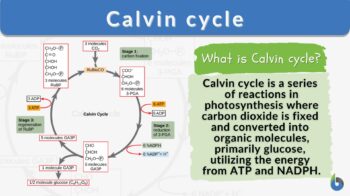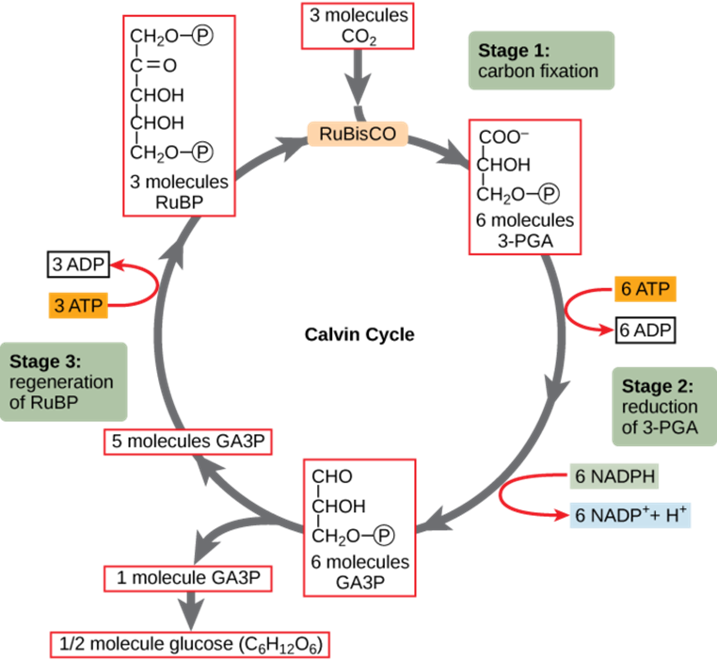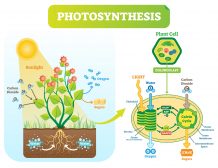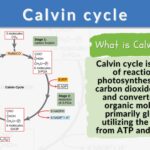
Calvin cycle
n., plural: calvin cycles
[ˈkælvɪn ˈsaɪ.kl̩]
Definition: Biochemical process in photosynthesis that converts carbon dioxide into glucose
Table of Contents
Calvin Cycle Definition
The Calvin cycle, also known as the Calvin Benson cycle or the dark reactions, is a series of biochemical reactions that take place in the stroma (fluid-filled space) of chloroplasts during photosynthesis. It was named after the American biochemist Melvin Calvin and his colleagues, who elucidated the pathway in the 1950s.
The Calvin cycle is an essential part of the photosynthetic process in plants, algae, and some bacteria. Its primary function is to convert carbon dioxide molecules from the atmosphere into organic molecules, particularly glucose, which serves as an energy source for the organism. The cycle is driven by the energy-rich molecules produced during the light-dependent reactions (the light reaction) of photosynthesis.
As the Calvin cycle did not get direct energy from photons from the sun, the Calvin cycle reactions are also frequently referred to as the “light-independent” reactions of photosynthesis. This is because of how the Calvin cycle works. Instead of using photons to fuel the Calvin cycle, light-dependent processes harvest the energy from photons and convert it into ATP and NADPH, which are then used to power the Calvin cycle.

Watch this vid about the Calvin cycle:
Biology definition:
The Calvin Cycle is a cyclical series or process where plants use carbon dioxide (CO2) from the air and energy from sunlight to produce sugar (glucose). It occurs in the chloroplasts (stroma) of plant cells and helps them make food for growth and survival. It includes light-independent reactions (e.g., carbon fixation, reduction reactions) and ribulose 1,5-diphosphate (RuDP) to produce sugars and starch as end products.
Overview:
At this stage of photosynthesis, the energy released from ATP produced during light reactions is used to drive the conversion of carbon dioxide and other compounds into an organic molecule (e.g. glucose). In C3 plants, the Calvin cycle is used directly to fix carbon dioxide. In C4 plants and CAM plants, a different carbon fixation precedes the Calvin cycle.
Word origin: named after one of the discoverers, Melvin Calvin, a Nobel prize-winning chemist.
Variants: Calvin-Benson cycle; Calvin-Benson-Bassham cycle (CBB cycle)
Synonyms: dark reaction of photosynthesis; C3 cycle; Carbon fixation cycle; Carbon reduction cycle; Photosynthetic carbon reduction cycle; Reductive pentose phosphate cycle
-
History
Scientists have known that photosynthesis turns carbon dioxide and water into sugar (carbohydrates) for ages. They weren’t sure how. Dr. Melvin Calvin, a scientist at the University of California at Berkeley, discovered photosynthesis 50 years ago.
Calvin grew green algae in the Berkeley Old Radiation Lab. He used green algae (Chlorella) use to understand how they photosynthesize. Calvin put algae in a contraption he called “lollipop” to study the process of carbon fixation. Calvin illuminated the lollipop and tracked carbon-14 through the algae’s chloroplast, where photosynthesis occurs. This revealed how plants generate sugar from carbon dioxide.
Calvin’s lollipop experiment and Calvin cycle:
Function Of The Calvin Cycle
- The Calvin cycle’s main task is to synthesize three-carbon molecules of sugars, which act as building blocks for other crucial carbohydrate molecules like glucose, starch, and cellulose. By directly assimilating carbon molecules from the atmosphere, this cycle facilitates the conversion of inorganic form carbon into vital plant biomass.
- Since plants are at the bottom of the energy pyramid, the significance of the Calvin cycle goes all the way to the base of most ecosystems. This cycle allows herbivores to store energy in a form that can be digested, and it allows carnivores to access the energy retained by herbivore bodies.
- The carbon skeletons synthesized by the Calvin cycle are essential for the production of proteins, lipids, nucleic acids, and other basic biomolecules required for life in the animal and plant kingdoms.
- An additional critical role of the Calvin cycle lies in its regulatory impact on carbon dioxide levels, a greenhouse gas, in the Earth’s atmosphere. The concerns raised by scientists arise not only due to the significant release of CO2 from the combustion of coal, oil, and gasoline but also from the extensive deforestation, which considerably hampers the capacity of forests to absorb and sequester carbon dioxide from the air.
- Photosynthetic organisms in marine ecosystems, such as phytoplankton, also utilize the Calvin cycle. Carbon dioxide molecules are fixed from seawater and converted into organic matter. This process plays a crucial role in maintaining the balance of carbon dioxide molecules in the oceans and contributes to the global carbon cycle.
- While the Calvin cycle is primarily associated with plants, algae, and some photosynthetic bacteria, other types of bacteria employ alternative carbon fixation pathways. For example, certain bacteria use the reductive tricarboxylic acid (rTCA) cycle, similar to the Calvin cycle, to assimilate carbon dioxide under specific environmental conditions.
- Some organisms, known as extremophiles, can thrive in harsh environments with limited access to water or high salinity. The Calvin cycle is vital for carbon assimilation in these extreme habitats, enabling certain microorganisms to survive and contribute to their ecosystems’ ecological dynamics.
- The Calvin cycle not only produces three-carbon sugars but also influences how these molecules are partitioned within the plant. Some of the G3P molecules are transported out of the chloroplast to the cytoplasm, where they are utilized for various biosynthetic pathways, including the synthesis of lipids, amino acids, and secondary metabolites.
- The Calvin cycle is sensitive to changes in environmental factors, such as light intensity, temperature, and water availability. In response to stressors, plants can adjust the activity of the cycle to optimize carbon fixation while maintaining energy efficiency and reducing oxidative damage.
- While the Calvin cycle consumes carbon dioxide, it also contributes to oxygen production through the light reactions of photosynthesis. The oxygen generated during photosynthesis is vital for aerobic organisms’ respiration and plays a critical role in Earth’s atmospheric composition.
- The Calvin cycle exhibits different rates of carbon isotope discrimination, which is the preferential uptake of certain carbon isotopes (e.g., carbon-12 and carbon-13). This isotopic discrimination can provide valuable information about past environmental conditions, helping scientists reconstruct climate history from plant fossils and sediments.
- The Calvin cycle is intrinsically linked to various biogeochemical cycles, such as the carbon cycle, nitrogen cycle, and phosphorus cycle. The interactions between these cycles influence nutrient availability and ecosystem functioning, impacting the productivity and diversity of ecosystems.
- The efficiency and regulation of the Calvin cycle in different plant species can affect their ecological competitiveness and, consequently, their impact on biodiversity in various habitats.
Calvin Cycle Steps
-
Step 1: Carbon Fixation
When a molecule of CO2 from the environment joins up with another molecule that contains five carbons and is known as ribulose-1,5-bisphosphate (RuBP), this process is called carbon fixation.
The resulting chemical containing six carbon atoms is subsequently broken down into two molecules of a compound containing three carbon atoms called 3-phosphoglyceric acid (3-PGA).
This process is sped up by an enzyme called RuBP carboxylase/oxygenase, which is also sometimes called RuBisCO. Because it is so important to photosynthesis, RuBisCo is probably one of the most frequent enzymes on Earth.
-
Step 2: Reduction
Glyceraldehyde 3-phosphate (G3P) is produced by converting six molecules of 3-PGA using ATP and NADPH. Since 3-PGA is gaining electrons, this is a reduction reaction. An atom or molecule gains an electron by a reduction. Both ATP and NADPH, at amounts of six each, are utilized. When the terminal phosphate of ATP is removed, energy is released, resulting in ADP; when the hydrogen atom of NADPH is removed, NADP+ energy carrier is formed. Both of these compounds are recycled by local light-dependent processes.
-
Step 3: Regeneration
Some of the molecules of glyceraldehyde-3 phosphate are used in the production of glucose molecules, while the rest are recycled to regenerate the five-carbon RuBP compound. This compound is what is used to receive fresh molecules of carbon.
ATP is essential to the process of regeneration. It is a difficult process that consists of a lot of different steps.
To produce a single molecule of glucose, it is necessary to go through this cycle a total of six times. This is because glucose is composed of six carbon compounds.
To balance this equation, the Calvin cycle regenerates five of the six glyceraldehyde-3-phosphate molecules into RuBP. The sixth one exits the cycle and changes into a glucose molecule pair.
Calvin Cycle Diagram
Here is a diagram depicting the process of the Calvin Cycle divided into three processes as discussed above.

Calvin Cycle Products
Each stage of the Calvin cycle “fixes” one carbon molecule for sugar synthesis. The Calvin cycle must be completed three times before a single molecule of glyceraldehyde-3 phosphate can be produced. Thus, two molecules of glyceraldehyde-3 phosphate can be combined after six rounds of the Calvin cycle and produce one molecule of glucose (which contains six carbons).
In each turn of the Calvin cycle, 3 ATP and 2 NADPH are consumed during the reduction of 3-phosphoglyceric acid to produce glyceraldehyde-3 phosphate. Additionally, this energy is utilized in the regeneration of ribulose-1,5-bisphosphate (RuBP), enabling the acceptance of a fresh carbon atom from atmospheric carbon dioxide (CO2) in the carbon fixation step. Both of these mechanisms are essential for the synthesis of glyceraldehyde-3 phosphate. This indicates that the production of one glucose molecule will likely make use of 18 molecules of ATP and 12 molecules of NADPH.
(Take note though that the exact number of ATP and NADPH molecules used can vary depending on the plant species and other factors.)

Facts About Calvin Cycle
- Nobel Prize: The Calvin cycle is named after the American biochemist Melvin Calvin, who, along with Andrew Benson and James Bassham, received the Nobel Prize in Chemistry in 1961 for elucidating the pathway of carbon fixation during photosynthesis.
- Discovery: The initial understanding of the Calvin cycle came from experiments performed in the 1940s and 1950s using radioactive isotopes of carbon, which allowed researchers to track the flow of carbon in photosynthetic reactions.
- Light-Independent Reactions: The Calvin cycle is often referred to as the “light-independent reactions” of photosynthesis because it does not directly require light energy. However, it relies on the ATP and NADPH produced during the light-dependent reactions to drive its processes.
- Carbon Fixation Rates: Under optimal conditions, the Calvin cycle can fix hundreds of billions of tons of carbon dioxide annually on a global scale, making it one of the most crucial biochemical processes on Earth.
- Rate-Limiting Step: The enzyme Rubisco, responsible for catalyzing the first step of carbon fixation, is often considered the most abundant protein on Earth. However, it is also known to be relatively slow and inefficient, leading to it being the rate-limiting step of the Calvin cycle.
- Photorespiration: Rubisco can accidentally mix with oxygen instead of carbon dioxide when it is hot and dry. This wasteful process is called photorespiration. This process makes carbon fixation less effective and can stop plants from growing. Some plants have developed special ways to reduce photorespiration, such as C4 photosynthesis and CAM photosynthesis.
- Carbon Isotope Discrimination: The Calvin cycle exhibits different rates of carbon isotope discrimination for carbon-12 and carbon-13 isotopes. The resulting isotopic signature in plant tissues provides valuable information to scientists studying past climates and ecological changes using stable isotopes.
- Evolutionary Significance: The Calvin cycle evolved relatively early in Earth’s history, and its development played a crucial role in shaping the planet’s atmosphere by reducing carbon dioxide levels and increasing oxygen concentrations.
- Biotechnology Applications: Researchers are actively investigating ways to improve the efficiency of the Calvin cycle in plants through genetic engineering, intending to develop crops with higher productivity and resilience to environmental stressors.
- Climate Change Impact: The Calvin cycle, together with the rest of photosynthesis, helps slow down climate change by taking carbon dioxide out of the air and storing it in plant matter and earth.
NOTE IT!
Takeaways
- The Calvin Cycle, a fundamental process in photosynthesis, plays a crucial role in converting six carbon dioxide molecules into a single six-carbon glucose molecule. This cycle takes place in the stroma of chloroplasts and relies on energy carriers such as ATP and NADPH, which are generated during light-dependent reactions. Initially, the Calvin Cycle fixes three carbon dioxide molecules to form two three-carbon compounds, which later undergo a series of chemical reactions involving fixation, reduction, and regeneration.
- For every three molecules of CO2 taken in by the plant, six molecules of a three-carbon compound called phosphoglycerate are produced. These six molecules go through a series of reactions to form one molecule of glucose. In this way, plants are able to “fix” carbon from the air into a more complex sugar molecule, enabling them to store energy for their growth and metabolism.
- This process produces chemical bonds which are later rearranged, leading to the synthesis of a three-carbon compound, glyceraldehyde-3-phosphate (G3P). Some G3P molecules are used to regenerate the initial three-carbon acceptor, while others are used to produce glucose and other essential molecules in the plant. Ultimately, the cycle ensures the continuous production of energy-rich compounds that drive various metabolic processes within the plant.
- This cycle has a fundamental importance in the production of organic molecules and its impact on the global carbon cycle make it an ongoing subject of study and fascination in the scientific community. Its complexities and regulatory mechanisms continue to be unraveled through research, contributing to advancements in various fields, from agriculture to climate science.
Take the Calvin Cycle – Biology Quiz!
References
- “The Calvin cycle. “ (2023) Retrieved 06 August, 2023, from https://www.khanacademy.org/science/ap-biology/cellular-energetics/photosynthesis/a/calvin-cycle
- bio.libretexts.org (2023). The Calvin Cycle. Retrieved 06 August 2023, from https://bio.libretexts.org/Bookshelves/Microbiology/Microbiology_(Boundless)/05%3A_Microbial_Metabolism/5.12%3A_Biosynthesis/5.12C%3A_The_Calvin_Cycle
- opentextbc.ca (2023). The Calvin Cycle. Retrieved 06 August, 2023, from https://opentextbc.ca/biology/chapter/5-3-the-calvin-cycle/
- “Sweet Secret.” (2023). Retrieved 06 August, 2023, from https://education.nationalgeographic.org/resource/sweet-secret/
©BiologyOnline.com. Content provided and moderated by Biology Online Editors.



